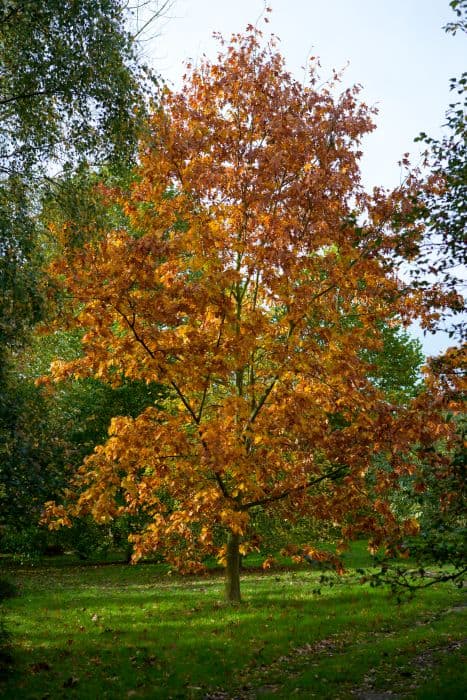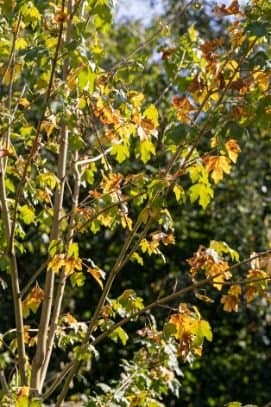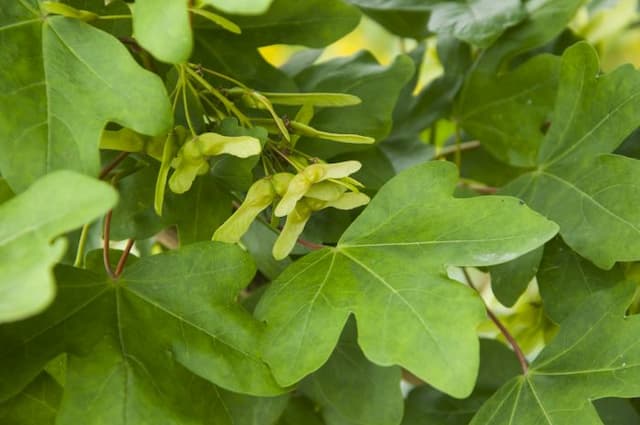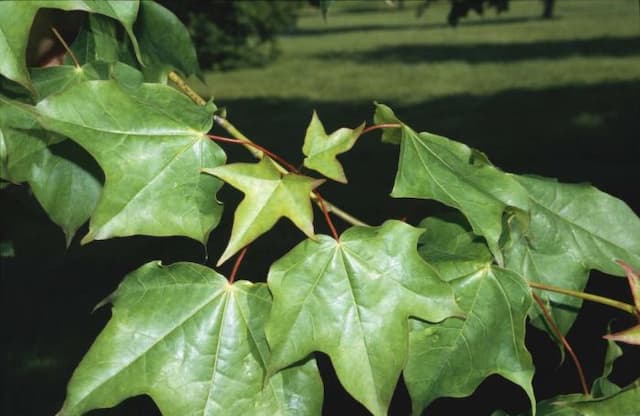Drummond Norway Maple Acer platanoides 'Drummondii' (v)

ABOUT
The Norway maple 'Drummondii' is a striking variety known for its unique foliage and overall aesthetic appeal as an ornamental tree. The leaves are its most distinctive feature, displaying a characteristic variegation. Each leaf comprises five pointed lobes and typically measures several inches across. The variegated leaves have a creamy white or light yellow border that contrasts beautifully against the central green area. This vibrant edge highlights the classic maple leaf shape, making it a visual standout throughout the growing season. In spring, clusters of modest, yellow-green flowers emerge before the leaves fully develop. The blooms are not overly showy but add to the tree's springtime interest. As the seasons progress, the leaves can exhibit varying shades of green with their bright edges, before transitioning to yellow hues in the fall, contributing to the tree's seasonal charm. The tree's bark is another noteworthy aspect, starting smooth and gray when young but becoming more furrowed and rugged with age, adding to the tree's textural interest year-round. The overall canopy of the Norway maple 'Drummondii' tends to be dense, forming a rounded shape that offers ample shade beneath, making it a popular choice for landscaping purposes where its striking foliage can be showcased prominently.
About this plant
 Names
NamesFamily
Sapindaceae.
Synonyms
Drummond Norway Maple, Variegated Norway Maple.
Common names
Acer platanoides 'Drummondii'
 Toxicity
ToxicityTo humans
Norway maple is generally not considered highly toxic to humans. However, all parts of the tree, particularly the sap, may contain toxic components. If ingested in large quantities, it could potentially cause stomach upset or discomfort. It is always best to avoid eating parts of ornamental plants due to possible adverse effects.
To pets
Norway maple is not typically listed as a toxic plant for pets. However, as with humans, the ingestion of plant parts, especially in large amounts, may cause mild gastrointestinal upset in some animals. Symptoms could include vomiting or diarrhea. It is advisable to discourage pets from eating ornamental plants as a precautionary measure.
 Characteristics
CharacteristicsLife cycle
Perennials
Foliage type
Deciduous
Color of leaves
Variegated
Flower color
Yellow
Height
35-45 feet (10.7-13.7 meters)
Spread
25-40 feet (7.6-12.2 meters)
Plant type
Tree
Hardiness zones
4
Native area
Europe
Benefits
 General Benefits
General Benefits- Aesthetic Appeal: Adds visual interest with its variegated foliage of green leaves with white margins.
- Shade Provider: Large canopy offers shade in gardens and parks during warm months.
- Seasonal Interest: Features bright yellow flowers in spring and foliage turns yellow or brown in autumn.
- Habitat Support: Provides food for wildlife such as birds, which feed on the winged seeds.
- Drought Tolerance: Once established, it has a degree of tolerance to short periods of dry conditions.
- Urban Tolerant: Capable of withstanding urban pollution and thrives in various city environments.
- Soil Adaptability: Grows in a wide range of soil types, though it prefers well-drained, fertile soils.
 Medical Properties
Medical PropertiesThis plant is not used for medical purposes.
 Air-purifying Qualities
Air-purifying QualitiesThis plant is not specifically known for air purifying qualities.
 Other Uses
Other Uses- Norway Maple 'Drummondii' wood can be utilized in woodworking and carpentry, particularly for its decorative grain in making furniture or interior trim.
- The bark of Norway Maple 'Drummondii' may be used in tanning leather due to the presence of tannins.
- As it is a relatively large tree, Norway Maple 'Drummondii' can be used as a windbreak or to reduce noise pollution when planted in rows or groups.
- The dense canopy of the Norway Maple 'Drummondii' offers habitat and nesting sites for birds and other urban wildlife.
- Seasonally, the leaves can serve as a natural mulch, decomposing to enrich the soil with organic matter.
- Wood from Norway Maple 'Drummondii' is sometimes used for smoking food, imparting a unique flavor to meats and cheeses.
- Dried leaves of Norway Maple 'Drummondii' can be used in creative arts for making botanical prints or inclusions in paper-making.
- Seed samaras of Norway Maple 'Drummondii' can be used in educational settings to explain principles of aerodynamics to students.
- The robust branches of Norway Maple 'Drummondii' may be used as natural supports for climbing plants or espaliers in landscaping.
- In winter, the silhouette of Norway Maple 'Drummondii' against the sky can be appreciated for its aesthetic contribution to the landscape.
Interesting Facts
 Feng Shui
Feng ShuiThe Norway maple is not used in Feng Shui practice.
 Zodiac Sign Compitability
Zodiac Sign CompitabilityThe Norway maple is not used in astrology practice.
 Plant Symbolism
Plant Symbolism- Strength: Acer platanoides, commonly known as the Norway Maple, embodies strength due to its sturdy wood and resilience in urban environments.
- Longevity: With a potential to live over a century, the Norway Maple symbolizes a long and enduring life.
- Protection: The dense canopy provided by the Norway Maple offers shelter and is thus symbolic of protection and safety.
- Beauty: The variegated foliage of the 'Drummondii' variant, with its contrasting green and white leaves, signifies beauty and uniqueness.
 Water
WaterThe Harlequin Maple requires consistent moisture and should be watered once a week with approximately 1 to 1.5 gallons of water, increasing to twice a week during hot, dry periods. It's best to water this tree deeply and slowly to ensure the soil is moistened to a depth of at least 6 inches. Young trees especially benefit from regular watering until they establish a strong root system. It's crucial not to overwater, as standing water can lead to root rot. In the fall, reducing the amount of water can help the tree prepare for winter.
 Light
LightHarlequin Maples flourish in full sun to partial shade. An ideal location would offer morning sunlight and some afternoon shade to protect the vibrant foliage from harsh direct afternoon rays. These trees are adaptable but providing the right balance of light will ensure the leaves maintain their striking variegated patterns without scorching.
 Temperature
TemperatureHarlequin Maples are hardy in temperatures well below freezing and can tolerate winter lows down to -30°F, making them suitable for many temperate climates. They grow best when summer temperatures do not frequently exceed 90°F. The ideal temperature range for vigorous growth is between 60°F and 75°F.
 Pruning
PruningHarlequin Maples should be pruned to remove dead or damaged branches, improve structure, and enhance air circulation within the canopy. Pruning is best done in late winter or early spring before the sap starts flowing. Aim to prune the tree every 2 to 3 years, or as needed to maintain its shape and health. The ideal time for major pruning is when the tree is dormant.
 Cleaning
CleaningAs needed
 Soil
SoilThe Norway Maple 'Drummondii' prefers a well-draining soil mix that is rich in organic matter. A combination of loamy soil, peat, and sand in equal parts can provide the appropriate structure. It thrives in a soil pH ranging from 4.0 to 7.0, with a slightly acidic to neutral pH being optimal.
 Repotting
RepottingThe Norway Maple 'Drummondii' being a large tree, is not typically repotted. Instead, it is planted once and allowed to grow in situ. Repotting in a container is not applicable as this tree is suited for outdoor growth in the landscape.
 Humidity & Misting
Humidity & MistingNorway Maple 'Drummondii' is adaptable to typical outdoor humidity levels and does not require specific humidity conditions when planted in the ground outdoors. It is not typically a concern for this hardy tree.
 Suitable locations
Suitable locationsIndoor
Not suitable for indoor growth; needs outdoor space.
Outdoor
Plant in well-draining soil, full sun to partial shade.
Hardiness zone
4-7 USDA
 Life cycle
Life cycleThe life of the Norway Maple 'Drummondii' variety begins with seed germination, typically in the spring, when soil temperatures warm up and moisture conditions are ideal. After germination, the seedling grows into a young sapling, developing a root system and a woody stem. Over several years, the sapling matures into an adult tree, producing characteristic variegated leaves that are green with white margins and developing a broad crown. The mature Norway Maple 'Drummondii' is capable of producing flowers in early spring before the foliage, which are followed by the development of winged seeds, or samaras, that disperse in the wind for propagation. Throughout its life, the tree undergoes seasonal changes, with leaves turning yellow in the fall before shedding, and enters a period of dormancy in winter. The Norway Maple 'Drummondii' has a potential lifespan of several decades if growing under optimal conditions and can reach considerable heights and widths, making it a significant landscape tree.
 Propogation
PropogationPropogation time
Spring-Early Summer
The Norway Maple 'Drummondii' is commonly propagated through seed sowing and softwood cuttings. For seeds, they should be collected when ripe and sown in the fall after a period of cold stratification to break dormancy. Cuttings, on the other hand, should be taken in late spring or early summer when the plant is actively growing. A softwood cutting is usually 4 to 6 inches long and contains at least two sets of leaves. The base of the cutting is dipped into a rooting hormone to enhance root development and then inserted into a well-draining soil mixture. The environment should be kept humid, and the temperature should be around 70°F (approximately 21°C). Roots typically develop within a few weeks, after which the new plants can be gradually acclimatized to less controlled conditions. This method is popular due to its relatively high success rate and production of mature plants more quickly than with seeds.







![Freeman maple [Autumn Blaze]](/_next/image?url=https%3A%2F%2Fplants-admin.emdemapps.com%2Fimages%2Fplants%2F%2Fimages%2F604b575b84d87.png&w=640&q=75)

